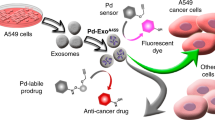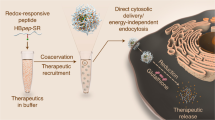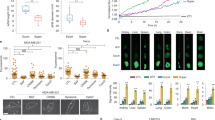Abstract
Controlled activation is a critical component in prodrug development. Here we report a concentration-sensitive platform approach for bioorthogonal prodrug activation by taking advantage of reaction kinetics. Using two ‘click and release’ systems, we demonstrate enrichment and prodrug activation specifically in mitochondria to demonstrate the principle of the approach. In both cases, the payload (doxorubicin or carbon monoxide) was released inside the mitochondrial matrix following the enrichment-initiated click reaction. Furthermore, mitochondria-targeted delivery yielded substantial augmentation of functional biological and therapeutic effects in vitro and in vivo when compared to controls, which did not result in enrichment. This method is thus a platform for targeted drug delivery that is amenable to conjugation with a variety of molecules and is not limited to cell-surface delivery. Taken together, these two 'click and release' pairs clearly demonstrate the concept of enrichment-triggered drug release and the critical feasibility of treating clinically relevant diseases such as acute liver injury and cancer.
This is a preview of subscription content, access via your institution
Access options
Access Nature and 54 other Nature Portfolio journals
Get Nature+, our best-value online-access subscription
$29.99 / 30 days
cancel any time
Subscribe to this journal
Receive 12 print issues and online access
$259.00 per year
only $21.58 per issue
Buy this article
- Purchase on Springer Link
- Instant access to full article PDF
Prices may be subject to local taxes which are calculated during checkout




Similar content being viewed by others
References
Wang, B., Hu, L. & Siahaan, T. J. (eds) Drug Delivery: Principles and Applications 2nd edn (Drug Discovery and Development Series, Wiley, Hoboken 2016).
He, X., Li, J., An, S. & Jiang, C. pH-sensitive drug-delivery systems for tumor targeting. Ther. Deliv. 4, 1499–1510 (2013).
Saravanakumar, G., Kim, J. & Kim, W. J. Reactive-oxygen-species-responsive drug delivery systems: promises and challenges. Adv. Sci. 4, 1600124 (2017).
Quinn, J. F., Whittaker, M. R. & Davis, T. P. Glutathione responsive polymers and their application in drug delivery systems. Polym. Chem. 8, 97–126 (2017).
Al-Nahain, A. et al. Triggered pH/redox responsive release of doxorubicin from prepared highly stable graphene with thiol grafted Pluronic. Int. J. Pharm. 450, 208–217 (2013).
Perez, C., Daniel, K. B. & Cohen, S. M. Evaluating prodrug strategies for esterase-triggered release of alcohols. ChemMedChem 8, 1662–1667 (2013).
Zheng, Y. et al. An esterase-sensitive prodrug approach for controllable delivery of persulfide species. Angew. Chem. Int. Ed. 56, 11749–11753 (2017).
Hamilton, J. R. & Trejo, J. Challenges and opportunities in protease-activated receptor drug development. Annu. Rev. Pharmacol. Toxicol. 57, 349–373 (2017).
Wiemer, A. J. & Wiemer, D. F. Prodrugs of phosphonates and phosphates: crossing the membrane barrier. Top. Curr. Chem. 360, 115–160 (2015).
Philip, A. K. & Philip, B. Colon targeted drug delivery systems: a review on primary and novel approaches. Oman Med. J. 25, 79–87 (2010).
Agarwal, P. & Bertozzi, C. R. Site-specific antibody–drug conjugates: the nexus of bioorthogonal chemistry, protein engineering, and drug development. Bioconjug. Chem. 26, 176–192 (2015).
Kern, J. C. et al. Discovery of pyrophosphate diesters as tunable, soluble, and bioorthogonal linkers for site-specific antibody–drug conjugates. J. Am. Chem. Soc. 138, 1430–1445 (2016).
Chudasama, V., Maruani, A. & Caddick, S. Recent advances in the construction of antibody–drug conjugates. Nat. Chem. 8, 114–119 (2016).
Zhao, X., Li, H. & Lee, R. J. Targeted drug delivery via folate receptors. Expert Opin. Drug Deliv. 5, 309–319 (2008).
Ahmed, M. & Narain, R. Carbohydrate-based materials for targeted delivery of drugs and genes to the liver. Nanomedicine (Lond.) 10, 2263–2288 (2015).
Jin, W. et al. Discovery of PSMA-specific peptide ligands for targeted drug delivery. Int. J. Pharm. 513, 138–147 (2016).
Ji, X. et al. Click and release: a chemical strategy toward developing gasotransmitter prodrugs by using an intramolecular Diels–Alder reaction. Angew. Chem. Int. Ed. 55, 15846–15851 (2016).
Wang, D. et al. A click-and-release approach to CO prodrugs. Chem. Commun. 50, 15890–15893 (2014).
Rossin, R. et al. Triggered drug release from an antibody–drug conjugate using fast ‘click-to-release’ chemistry in mice. Bioconjug. Chem. 27, 1697–1706 (2016).
Versteegen, R. M. et al. Click to release: instantaneous doxorubicin elimination upon tetrazine ligation. Angew. Chem. Int. Ed. 52, 14112–14116 (2013).
Matikonda, S. S. et al. Bioorthogonal prodrug activation driven by a strain-promoted 1,3-dipolar cycloaddition. Chem. Sci. 6, 1212–1218 (2015).
Ji, X. et al. Click and release: SO2 prodrugs with tunable release rates. Org. Lett. 19, 818–821 (2017).
Ji, X. et al. Click and fluoresce: a bioorthogonally activated smart probe for wash-free fluorescent labeling of biomolecules. J. Org. Chem. 82, 1471–1476 (2017).
Jimenez-Moreno, E. et al. Vinyl ether/tetrazine pair for the traceless release of alcohols in cells. Angew. Chem. Int. Ed. 56, 243–247 (2017).
Steiger, A. K., Yang, Y., Royzen, M. & Pluth, M. D. Bio-orthogonal ‘click-and-release’ donation of caged carbonyl sulfide (COS) and hydrogen sulfide (H2S). Chem. Commun. 53, 1378–1380 (2017).
Li, J., Jia, S. & Chen, P. R. Diels–Alder reaction-triggered bioorthogonal protein decaging in living cells. Nat. Chem. Biol. 10, 1003–1005 (2014).
Eising, S., Lelivelt, F. & Bonger, K. M. Vinylboronic acids as fast reacting, synthetically accessible, and stable bioorthogonal reactants in the Carboni–Lindsey reaction. Angew. Chem. Int. Ed. 55, 12243–12247 (2016).
Luo, J., Liu, Q., Morihiro, K. & Deiters, A. Small-molecule control of protein function through Staudinger reduction. Nat. Chem. 8, 1027–1034 (2016).
Anseth, K. S. & Klok, H.-A. Click chemistry in biomaterials, nanomedicine, and drug delivery. Biomacromolecules 17, 1–3 (2016).
Kang, J., Hilmersson, G., Santamaría, J. & Rebek, J. Diels–Alder reactions through reversible encapsulation. J. Am. Chem. Soc. 120, 3650–3656 (1998).
Murase, T., Horiuchi, S. & Fujita, M. Naphthalene Diels–Alder in a self-assembled molecular flask. J. Am. Chem. Soc. 132, 2866–2867 (2010).
Chen, W., Wang, D., Dai, C., Hamelberg, D. & Wang, B. Clicking 1,2,4,5-tetrazine and cyclooctynes with tunable reaction rates. Chem. Commun. 48, 1736–1738 (2012).
Wang, D. et al. 3,6-Substituted-1,2,4,5-tetrazines: tuning reaction rates for staged labeling applications. Org. Biomol. Chem. 12, 3950–3955 (2014).
Shan, D., Nicolaou, M. G., Borchardt, R. T. & Wang, B. Prodrug strategies based on intramolecular cyclization reactions. J. Pharm. Sci. 86, 765–767 (1997).
Murphy, M. P. & Smith, R. A. J. Targeting antioxidants to mitochondria by conjugation to lipophilic cations. Ann. Rev. Pharmacol. Toxicol. 47, 629–656 (2007).
Blackman, M. L., Royzen, M. & Fox, J. M. Tetrazine ligation: fast bioconjugation based on inverse-electron-demand Diels–Alder reactivity. J. Am. Chem. Soc. 130, 13518–13519 (2008).
Devaraj, N. K., Weissleder, R. & Hilderbrand, S. A. Tetrazine-based cycloadditions: application to pretargeted live cell imaging. Bioconjug. Chem. 19, 2297–2299 (2008).
Smith, R. A. J., Porteous, C. M., Gane, A. M. & Murphy, M. P. Delivery of bioactive molecules to mitochondria in vivo. Proc. Natl Acad. Sci. USA 100, 5407–5412 (2003).
Janssen, M. J. H., Crommelin, D. J. A., Storm, G. & Hulshoff, A. Doxorubicin decomposition on storage. Effect of pH, type of buffer and liposome encapsulation. Int. J. Pharm. 23, 1–11 (1985).
Otterbein, L. E. et al. Carbon monoxide has anti-inflammatory effects involving the mitogen-activated protein kinase pathway. Nat. Med. 6, 422–428 (2000).
Otterbein, L. E. et al. Carbon monoxide suppresses arteriosclerotic lesions associated with chronic graft rejection and with balloon injury. Nat. Med. 9, 183–190 (2003).
Klinger-Strobel, M. et al. Bactericidal effect of a photoresponsive carbon monoxide-releasing nonwoven against Staphylococcus aureus biofilms. Antimicrob. Agents Chemother. 60, 4037–4046 (2016).
Clark, J. E. et al. Cardioprotective actions by a water-soluble carbon monoxide-releasing molecule. Circ. Res. 93, e2–e8 (2003).
Nagel, C. et al. Introducing [Mn(CO)3(tpa-κ3 N)]+ as a novel photoactivatable CO-releasing molecule with well-defined iCORM intermediates—synthesis, spectroscopy, and antibacterial activity. Dalton Trans. 43, 9986–9997 (2014).
Kuramitsu, K. et al. Carbon monoxide enhances early liver regeneration in mice after hepatectomy. Hepatology 53, 2016–2026 (2011).
Motterlini, R. & Foresti, R. Biological signaling by carbon monoxide and carbon monoxide-releasing molecules. Am. J. Physiol. Cell. Physiol. 312, C302–C313 (2017).
Motterlini, R. et al. Carbon monoxide-releasing molecules: characterization of biochemical and vascular activities. Circ. Res. 90, E17–E24 (2002).
Pan, Z. et al. Organic CO prodrugs: structure–CO-release rate relationship studies. Chem. Eur. J. 23, 9838–9845 (2017).
Hernandez-Aguilera, A. et al. Mitochondrial dysfunction: a basic mechanism in inflammation-related non-communicable diseases and therapeutic opportunities. Mediat. Inflamm. 2013, 135698 (2013).
Sawle, P. et al. Carbon monoxide-releasing molecules (CO-RMs) attenuate the inflammatory response elicited by lipopolysaccharide in RAW264.7 murine macrophages. Br. J. Pharmacol. 145, 800–810 (2005).
Schallner, N. & Otterbein, L. E. Friend or foe? Carbon monoxide and the mitochondria. Front. Physiol. 6, 17 (2015).
Marques, A. R. et al. Generation of carbon monoxide releasing molecules (CO-RMs) as drug candidates for the treatment of acute liver injury: targeting of CO-RMs to the liver. Organometallics 31, 5810–5822 (2012).
Zuckerbraun, B. S. et al. Carbon monoxide protects against liver failure through nitric oxide-induced heme oxygenase 1. J. Exp. Med. 198, 1707–1716 (2003).
Motterlini, R. & Otterbein, L. E. The therapeutic potential of carbon monoxide. Nat. Rev. Drug Discov. 9, 728–743 (2010).
Robinson, M. W., Harmon, C. & O’Farrelly, C. Liver immunology and its role in inflammation and homeostasis. Cell. Mol. Immunol. 13, 267–276 (2016).
Bradley, M. J. et al. Host responses to concurrent combined injuries in non-human primates. J. Inflamm. 14, 23 (2017).
Queiroga, C. S. F., Almeida, A. S. & Vieira, H. L. A. Carbon monoxide targeting mitochondria. Biochem. Res. Int. 2012, 749845 (2012).
Acknowledgements
The authors thank Z. Liu at the Center for Molecular and Translational Medicine at Georgia State University for taking confocal images. The authors also acknowledge GSU Molecular Basis of Disease (Z.P. and M.R.C.), Brains & Behaviors (B.Y.) and University 2CI (L.K.C.d.l.C.) fellowships for their support, and the Department of Defense Peer Reviewed Medical Research Program (W81XWH-16-0464 and NIH R44 DK111260-02 to L.E.O.).
Author information
Authors and Affiliations
Contributions
B.W. conceived the initial idea, and supervised the study and the overall manuscript preparation and revision process. B.W. also revised the manuscript. Y.Z. and X.J. designed and performed the experiments, and drafted the manuscript. B.Y. and K.J. conducted the in vitro biology studies. D.G. and E.C. performed the in vivo studies. M.Z carried out the computational work. M.R.C., L.K.C.d.l.D., V.C., Z.Y., and Z.P. conducted studies of the reaction kinetics and some of the synthesis. L.E.O supervised and/or performed the in vivo studies, analysed and interpreted the data, and revised the manuscript. All authors reviewed, edited and approved the manuscript.
Corresponding authors
Ethics declarations
Competing interests
L.E.O. is a scientific consultant for Hillhurst Biopharmaceuticals. All other authors declare no competing interests.
Additional information
Publisher’s note: Springer Nature remains neutral with regard to jurisdictional claims in published maps and institutional affiliations.
Supplementary information
Supplementary Information
Supplementary Methods, Supplementary Figures, and Supplementary Data
Rights and permissions
About this article
Cite this article
Zheng, Y., Ji, X., Yu, B. et al. Enrichment-triggered prodrug activation demonstrated through mitochondria-targeted delivery of doxorubicin and carbon monoxide. Nature Chem 10, 787–794 (2018). https://doi.org/10.1038/s41557-018-0055-2
Received:
Accepted:
Published:
Issue Date:
DOI: https://doi.org/10.1038/s41557-018-0055-2
This article is cited by
-
Ultrasound-driven self-decomposition porphyrins as metal-free CO precursors for gas and sonodynamic synergistic therapy
Science China Chemistry (2024)
-
Bioorthogonal Chemistry in Cellular Organelles
Topics in Current Chemistry (2024)
-
Continuous Spatiotemporal Therapy of A Full-API Nanodrug via Multi-Step Tandem Endogenous Biosynthesis
Nature Communications (2023)
-
Hydrogen-bonded organic framework-based bioorthogonal catalysis prevents drug metabolic inactivation
Nature Catalysis (2023)
-
Tumor-Penetrating and Mitochondria-Targeted Drug Delivery Overcomes Doxorubicin Resistance in Lung Cancer
Chinese Journal of Polymer Science (2023)



